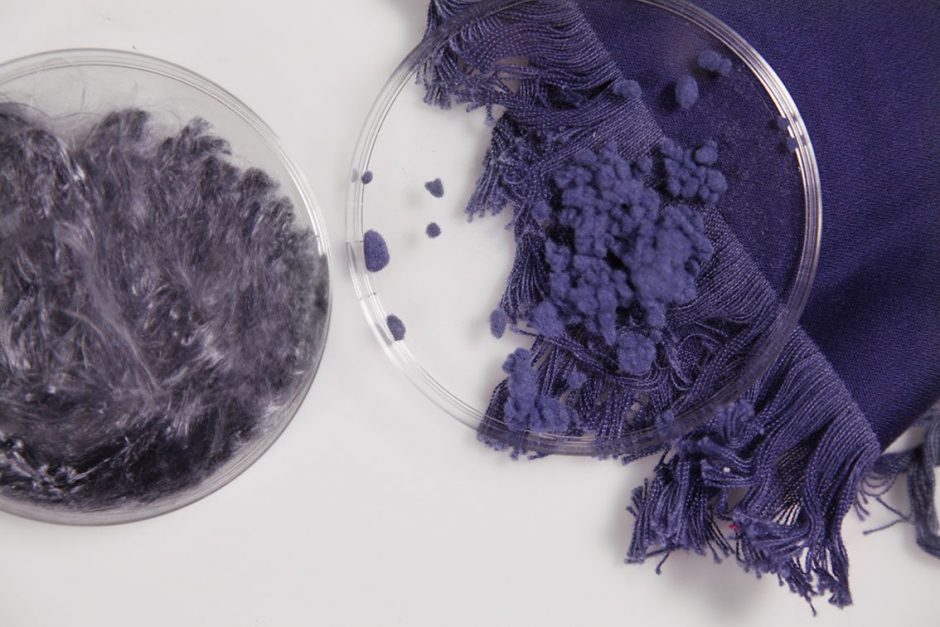The textile, garment and fashion industries generate tonnes of pollution each year and recycle very little, which has harmful effects on the environment and on humans. EIT Climate-KIC supported Ioncell directly addresses these global systemic issues by offering an innovation that regenerates fibers, while enabling them to be recyclable and biodegradable. Might it be the key to transitioning these unsustainable industries to a circular economy?
As textile consumption increases globally, so does textile waste
Overall, the global demand for textile fibers has been increasing heavily since after the second world war. In recent years, the aggregated annual growth for the whole market has been around two to three per cent and the market exceeded 100 million tonnes of fiber in 2017. Some fiber segments, like man-made cellulosic fibers (e.g. viscose, lyocell) have experienced growth rates of seven to eight per cent in recent years. Roughly two-thirds of this volume is made of petrochemical raw materials (e.g. polyester, polyamide) and one fifth is made of cotton. The remaining small share is made up of viscose (six per cent) and to a very small extent, lyocell, wool and silk.
Clothing is the second largest pollution source in the world. Now, the share of recycled textiles is around one per cent of the over one million tonnes produced annually. Therefore, significant amounts of textiles end up incinerated or in landfills, where they release greenhouse gases and leach toxins into the surrounding soil and waterways.
“One sees the great challenge the textile industry is facing. Now, all brand owners in the textile, garment and fashion industries are anxiously searching for more sustainable raw materials, production processes and a way to recycle textile waste,” said Jari Laine, Senior Innovation Advisor, Aalto University. “Generally, as a quick fix for the problem doesn’t exist, promising technologies, like Ioncell, are very much in demand.”

Ioncell, conceptualised out of Aalto University and supported by EIT Climate-KIC, provides a closed-loop technology to regenerate cellulosic fibers without using harmful chemicals. Ioncell fibers are strong, recyclable, bio-degradable and adaptable to a multitude of applications and raw materials. The uniqueness of Ioncell comes from a novel combination of an ionic liquid solvent and air-gap fiber spinning, a process which is both safe and environmentally sustainable.
The cellulosic raw material is first mechanically ground and pre-mixed and then it’s dissolved using an ionic liquid. The resulting viscous spinning dope is then pressed through very small holes to a water bath. Between the spinnerette and the bath there’s an air gap. The very thin fibers are collected from the bath on rotating cyliders. In case of staple fibers, the fibers are washed, cut, dried and opened after this process.
In addition to Ioncell appealing to all major brand owners in the textile, garment and fashion industries, many technical and health care applications are possible, as well as use in composites, tyre cords, filters and non-woven products like diapers and wipes, since Ioncell fibers have high tensile strength (almost double of that of cotton). Ioncell therefore offers the dual benefit of being more circular and more durable than other materials.
Global culture shift drives demand for closed loop systems
Shifts in Finland’s cultural attitude towards textile, garment and fashion production have also led to increased interest in—and adoption of—sustainable alternatives, such as the fibers produced by Ioncell:
“Most of the textile industry left Finland for low-cost countries following a global trend in the recent decades. The reason has been production cost driven—directly because of the cost of labour—but also to evade Finland’s comparatively stringent legislation against harmful processes like viscose manufacturing,” said Laine.
He continued: “Now we can see a small change of tide in this respect, as more and more small enterprises are founded in Finland, being designer-driven or focused on smaller segments with better profitability like children’s wear. Ioncell is very much in the center of this, with almost daily requests for samples and information from Finnish entrepreneurs wishing to replace oil-based or cotton-based materials with a more sustainable option. The Finnish Government has also been very supportive to new technologies in the cellulosic industry, like providing public funding through Business Finland and the Academy of Finland.”
It’s clear there are powerful synergies between Finland and Ioncell, especially in the research and development of the pulp industry, which is very prominent in Finland. Ioncell also has global relevance and is in close talks with most of the leading global brand owners.
Indeed, the global interest in Ioncell also reveals that these changes in cultural attitude towards textile, garment and fashion production—the increasing desire for sustainable processes—isn’t limited to Finland:
“What we’re already seeing is the change in purchasing behavious of young people in developed countries, like preferring second-hand stores more and being more sensitive to harmful raw materials,” said Laine.

However, there remains some challenges. Ideally, the design and materials selection of garments should support recycling (i.e. identification of materials, chemicals, etc. for easy, automated separation). Most of the clothes we wear are made of fiber blends, which more often than not contain fibers (e.g. elastane), which need to be separated from the cellulosic fibers before they can be chemically recycled.
Also, the take-back logistics, especially from consumers, including the identification, separation and chemical pre-handling of garments will need to improve and scale. Monetary and regulatory incentives could drive this change. The easiest way to increase recycling is using pre-consumer, factory-level textile waste, which is identifiable, more homogenous and available in large quantities on-site. Some of these activities are already ongoing in countries where the textile industry has been concentrating, like in India.
Recycling will be deeply embedded in healthy cities of the future
Laine forecasts that these positive trends will create ever-more demand for durable, lasting designs that can be sold to others after use and repaired or modified for new use. He also predicts we will see more recycled raw materials used in clothes, increases in mechanical recycling and more. Cities will be natural hubs for recycling and a sharing economy due to their density of population and exiting logistical arrangements and facilities for waste separation and recycling.
He continues: “Maybe we’ll see ‘Ioncell 2.0’ operating next to a waste management facility in an urban area of Copenhagen or Vienna someday…”
If more circular solutions emerge and scale, the positive effect on the environment would be remarkable, reducing or eliminating ecological harm that occurs throughout conventional production processes, such as pesticide use, ample water usage and therefore freshwater extraction, carbon emissions, and soil and water pollution with toxic chemicals.

We don’t yet know the multitude of effects unsustainable textile production has on human health in total, but we know that, for example, an increasing amount of micoplastics end up in the sea, in our drinking water, in the food we eat and even in the air we breathe. A new study in the journal Environmental Science and Technology says it’s possible humans are consuming 39,000 to 52,000 microplastic particles per year. With added estimates of how much microplastic might be inhaled, that number is over 74,000. And, people who meet their recommended water intake through tap water ingest another 4,000 plastic particles annually while those who drink only bottled water ingest an additional 90,000.
If we can reduce consumption more generally, while embedding recycling in all areas of society, these numbers will surely drop.
“When it’s a question of our health and especially of the health of our children and their children, hardly there could be any stronger motive to act,” said Laine.
Ioncell is in the process of building a small-scale, closed-loop pilot production line. It’s to be used as the ‘proof of concept,’ which will pave the way towards a commercial production plant. It’ll also be used to produce larger quantities of fiber, to be used for limited-edition runs for garment makers to be tested in consumer use in the field. During the piloting phase, the Ioncell team will research and select partnerships best suited for the next phases of scaling-up the innovation.

